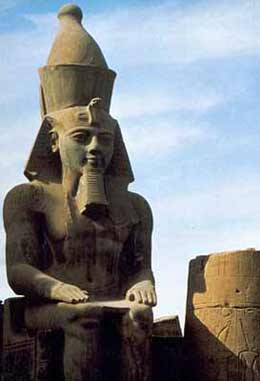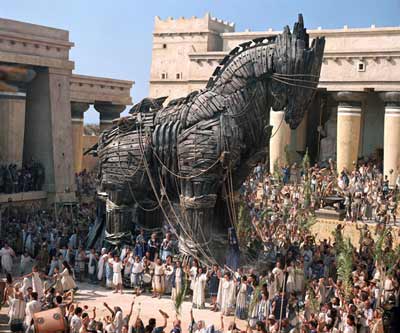
Pharaoh Ramesses II –
a barrier to progress
Neil Faulkner Archive | ETOL Main Page
Marxist History
Published online by Counterfire, 9 August 2010.
Copied with thanks from the Counterfire Website.
Marked up by Einde O’Callaghan for the Encyclopaedia of Trotskyism On-Line (ETOL).
Why did Bronze Age empires rise and fall amid crisis and war? And why did this contradictory social form simply replicate itself over long periods of time? Neil Faulkner looks at the evidence.

Pharaoh Ramesses II – |
Bronze Age empires rose and fell. The Akkadian Empire (based in Iraq) collapsed suddenly around 2190 BCE (before the common era) after about 140 years of existence. Equally sudden had been the overthrow of the Old Kingdom pharaohs in Egypt a short time before, around 2250 BCE.
Why did Early Bronze Age civilisation fail? Detail is lacking, but Egyptian sources record famine, a fragmentation of the state, and incursions by Libyan raiders from the west and Nubian raiders from the south. What is not clear, however, is why these things should have happened. Why was the once-strong centralised state of the pyramid-builders no longer able to feed the people, enforce its authority, and defend its borders?
This pattern of rise and fall was a repeating one. New empires emerged from the chaos of the Early Bronze Age crisis. Between 1600 and 1200 BCE, the Eastern Mediterranean was again divided between rival empires – New Kingdom Egypt, the Hittites of Anatolia (Turkey), the Mitanni of northern Mesopotamia (Iraq), and the Mycenaean Greeks.
This Late Bronze Age geopolitical system collapsed amid storm and strife during the 12th century BCE. The embattled New Kingdom pharaohs record co-ordinated attacks by Libyans and ‘northerners coming from all lands’. The latter were the more dangerous. These multi-ethnic ‘Sea Peoples’ formed great pirate fleets. ‘All at once,’ says Ramesses III, ‘these peoples were on the move ... No country could stand up to them.’

Homer’s legend of the Trojan War |
Pre-eminent as seafarers and warriors, Greeks were among these Sea Peoples. Homer’s Iliad and Odyssey are probably based on an orally transmitted record of real events that took place around 1190 BCE. The poems have transformed these events into tales of derring-do by legendary heroes. The kernel of truth about the Trojan War appears to be that it was a giant seaborne raid by Greek pirates intent on plunder.
So the Late Bronze Age empires collapsed as the Early Bronze Age empires had done. And when we look beyond the Mediterranean, to other places where civilisation developed at different times, we see the same – rise and fall.
The Indus civilisation of Mohenjo-daro and Harappa (in Pakistan) collapsed around 1900 BCE. Excavators found numerous unburied remains of people suddenly and violently killed in the uppermost levels of the great city of Mohenjo-daro.
Chinese history, from the Shang of the 2nd millennium BCE to the Manchu of 1644–1911 CE (common era), sees the rise and fall of a whole series of imperial dynasties, with occasional periods, sometimes lasting centuries, of division and civil war.
Throughout this period, Chinese civilisation was deeply conservative and essentially unchanging. The socio-economic order simply replicated itself, from generation to generation, from dynasty to dynasty. China provides an extreme example of the cyclical trajectory of ancient civilisation.
So we have two historical problems to confront. Why did ancient empires rise and fall? And why did this contradictory social form simply replicate itself over long periods of time?
The ancient world was characterised by stagnation of technique. On several occasions, humans had escaped the contradictions of an existing mode of production by transforming it. Global warming had destroyed the habitats of the big game on which Late Palaeolithic hunters depended. The response – the Neolithic Revolution – had achieved massive increases in productivity, output, and population through the adoption of crop cultivation and stock raising.
Soil exhaustion and population pressure had later created a crisis for this Early Neolithic mode of production. In the Urban Revolution, the contradictions were resolved with a second great leap forward, based on land reclamation, irrigation schemes, and the ploughing of fields.
But the Urban Revolution also conjured an impediment to further progress: the existence of a ruling class. We have charted its emergence. We have noted its roots in specialised religious, military, and political functions, and in the shortages and insecurities inherent in a primitive economic system. The first rulers were those whose social roles gave them control over scarce resources.
Why should the ruling class have been a barrier to new ideas? Surely it was in their interest to improve technique in order to increase surplus? Yes and no: as with all things in social life, there were contradictory pressures.
The new ruling classes sat uneasy on their pedestals. They were divided among themselves, family against family, city against city, tribe against tribe, empire against empire. Against domestic rivals, top families built retinues of loyalists and bodyguards. Against foreign enemies, they needed armies and fortresses.
The rulers were also divided from the mass of the people, who, because they were exploited, were potentially rebellious, and who therefore had to be cowed by a careful mix of force and fraud.
Force meant the threat posed by aristocratic retinues and by state forces. Fraud meant the ideological claim that the rulers played an essential role and acted in the public interest. Both force and fraud were embodied in the great monuments that dominate the archaeological record.

The pyramids – monuments to power and waste |
Take the pyramids of Old Kingdom Egypt. They were the royal tombs of god-kings who were expected to live for eternity. Monuments, that is, to a false ideology by which the ruler was elevated into a figure of awesome and intimidating power. The pyramids were designed to teach people their place. They were ideological weapons in a class war.
So the Bronze Age elites did not invest the surplus they controlled in improved technique and higher productivity. They wasted resources on military competition, prestige monuments, and, of course, their own luxury lifestyles. Power, propaganda, and privilege – not productivity – consumed the surpluses created by the labour of Bronze Age peasants.
This process was cumulative. The greed of the rich was never sated. The grandeur of past monuments set a standard to be surpassed by those that followed. Rulers competed in the luxury of their palaces, the splendour of their tombs, the art and architecture of their great cities.
Above all, military competition intensified as rival polities expanded and clashed. A slow-motion arms race can be detected in the Late Bronze Age world. There seem to be more soldiers, better armed, defending stronger fortresses in 1200 BCE than there had been in 1600 BCE. The world became more militarised.
Technique was stagnant, but surplus consumption was rising. War, monuments, and luxury meant a higher rate of exploitation and impoverishment of the peasantry. Over-accumulation at the top was mirrored by degradation of the system’s agricultural base.
The proud warrior-lords of the Late Bronze Age were a parasitic elite whose economic cost had become unsustainable. That is the deepest reason for the implosion of their world in the 12th century BCE.
But this was a problem without an internal solution. Stagnant technique meant socio-economic conservatism. There were no new forces growing inside the old society. The choice, therefore, was between the barbarism of invaders and a reincarnation of the old (failed) imperial civilisation.
Humanity was again at an impasse. Only this time, the existence of classes and states had raised formidable barriers to human creativity and progress.
Neil Faulkner Archive | ETOL Main Page
Eleven Reasons to Fight
Last updated on: 13 February 2022